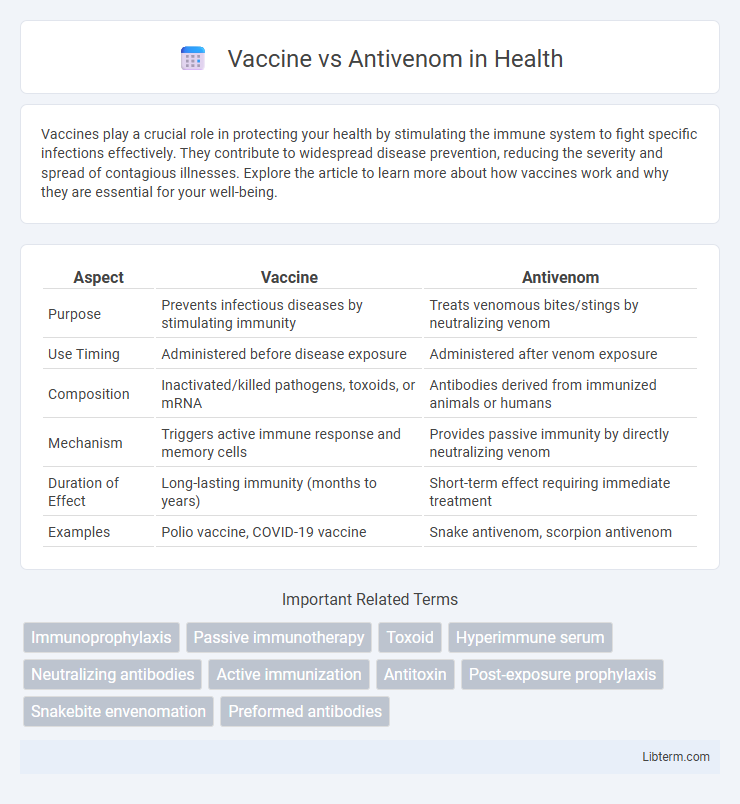Vaccines play a crucial role in protecting your health by stimulating the immune system to fight specific infections effectively. They contribute to widespread disease prevention, reducing the severity and spread of contagious illnesses. Explore the article to learn more about how vaccines work and why they are essential for your well-being.
Table of Comparison
| Aspect | Vaccine | Antivenom |
|---|---|---|
| Purpose | Prevents infectious diseases by stimulating immunity | Treats venomous bites/stings by neutralizing venom |
| Use Timing | Administered before disease exposure | Administered after venom exposure |
| Composition | Inactivated/killed pathogens, toxoids, or mRNA | Antibodies derived from immunized animals or humans |
| Mechanism | Triggers active immune response and memory cells | Provides passive immunity by directly neutralizing venom |
| Duration of Effect | Long-lasting immunity (months to years) | Short-term effect requiring immediate treatment |
| Examples | Polio vaccine, COVID-19 vaccine | Snake antivenom, scorpion antivenom |
Understanding Vaccines: Definition and Purpose
Vaccines are biological preparations designed to stimulate the immune system by introducing antigens that mimic pathogens, enabling the body to develop immunity against specific diseases. Their primary purpose is to prevent infectious diseases by training the immune system to recognize and combat viruses or bacteria before infection occurs. Unlike antivenoms, which provide passive immunity by neutralizing toxins after envenomation, vaccines promote active, long-lasting immunity through immune memory.
What Is Antivenom? Key Concepts Explained
Antivenom is a biological product used to treat venomous bites or stings by neutralizing toxins in the body, typically derived from the antibodies of animals immunized against specific venom. Unlike vaccines, which stimulate the immune system to prevent disease, antivenoms provide immediate passive immunity by directly counteracting toxic venom effects. Antivenoms are critical in managing envenomation from snakes, spiders, and scorpions, helping reduce morbidity and mortality after exposure.
The Science Behind How Vaccines Work
Vaccines stimulate the immune system by introducing antigens that mimic harmful pathogens, prompting the production of specific antibodies and memory cells for long-lasting protection. Antivenoms, on the other hand, are created by injecting venom into animals to generate antibodies that neutralize toxins, providing immediate but temporary immunity. The fundamental difference lies in vaccines activating adaptive immunity proactively, while antivenoms offer passive immunity by directly supplying protective antibodies.
Mechanism of Action: How Antivenoms Neutralize Toxins
Antivenoms neutralize toxins by containing specific antibodies that bind to venom components, preventing their interaction with physiological targets and facilitating toxin clearance from the bloodstream. This passive immunization mechanism contrasts with vaccines, which stimulate the recipient's immune system to produce its own antibodies over time. The effectiveness of antivenoms depends on the specificity and affinity of these antibodies for venom toxins, enabling rapid neutralization during envenomation.
Common Uses: Diseases Prevented by Vaccines
Vaccines primarily prevent infectious diseases such as measles, influenza, hepatitis B, and COVID-19 by stimulating the immune system to develop immunity without causing the disease. Antivenoms are used to treat envenomation from venomous bites or stings, such as snake bites, scorpion stings, and spider bites, neutralizing toxins rather than preventing disease. The widespread use of vaccines has led to the eradication or control of many viral and bacterial infections, significantly reducing morbidity and mortality worldwide.
Typical Applications: When Is Antivenom Administered?
Antivenom is typically administered immediately after a venomous bite or sting to neutralize toxins and prevent systemic damage. Common applications include snakebites, scorpion stings, and spider bites where rapid intervention is critical to reduce morbidity and mortality. Unlike vaccines, antivenoms provide passive immunity by supplying antibodies directly, offering immediate but short-term protection.
Production Processes: Vaccine vs Antivenom
Vaccine production involves the attenuation or inactivation of pathogens to stimulate the immune system to produce a targeted immune response, often using cell cultures or recombinant DNA technology. Antivenom production requires venom extraction from specific animals, followed by immunizing host animals such as horses or sheep to generate antibodies, which are then purified and formulated for therapeutic use. Both processes demand rigorous quality control and purification steps but differ fundamentally in their biological sources and immune targets.
Efficacy and Safety Considerations for Both Treatments
Vaccines stimulate the immune system to provide long-term protection by preventing disease, with efficacy rates often exceeding 90% for many infectious agents and generally low risk of adverse reactions. Antivenoms offer immediate, targeted neutralization of venom toxins, crucial for treating envenomation emergencies but may carry risks of allergic reactions or serum sickness, necessitating careful administration. Both treatments require rigorous clinical evaluation to balance effectiveness and safety, with vaccines prioritizing preventive immunization and antivenoms focused on acute therapeutic intervention.
Global Accessibility: Distribution of Vaccines vs Antivenoms
Global accessibility of vaccines significantly surpasses that of antivenoms due to established cold chain logistics, mass production capabilities, and widespread immunization programs supported by international health organizations. Antivenoms face challenges in distribution caused by limited production facilities, high costs, and the need for species-specific formulations, which hinder availability in rural and low-income regions most affected by venomous bites. Efforts to improve antivenom accessibility include developing broad-spectrum antivenoms and enhancing local production infrastructures to address uneven global distribution.
Future Developments: Innovations in Vaccines and Antivenoms
Emerging technologies such as mRNA platforms and recombinant DNA are revolutionizing vaccine and antivenom development, enabling faster production and enhanced specificity against diverse pathogens and venomous species. Advances in nanotechnology and bioinformatics facilitate the creation of more effective and stable vaccine formulations and antivenoms with reduced side effects and increased efficacy. Ongoing research into universal antidotes and synthetic antibody fragments promises broader protection and improved accessibility in managing venom-related and infectious diseases.
Vaccine Infographic

 libterm.com
libterm.com